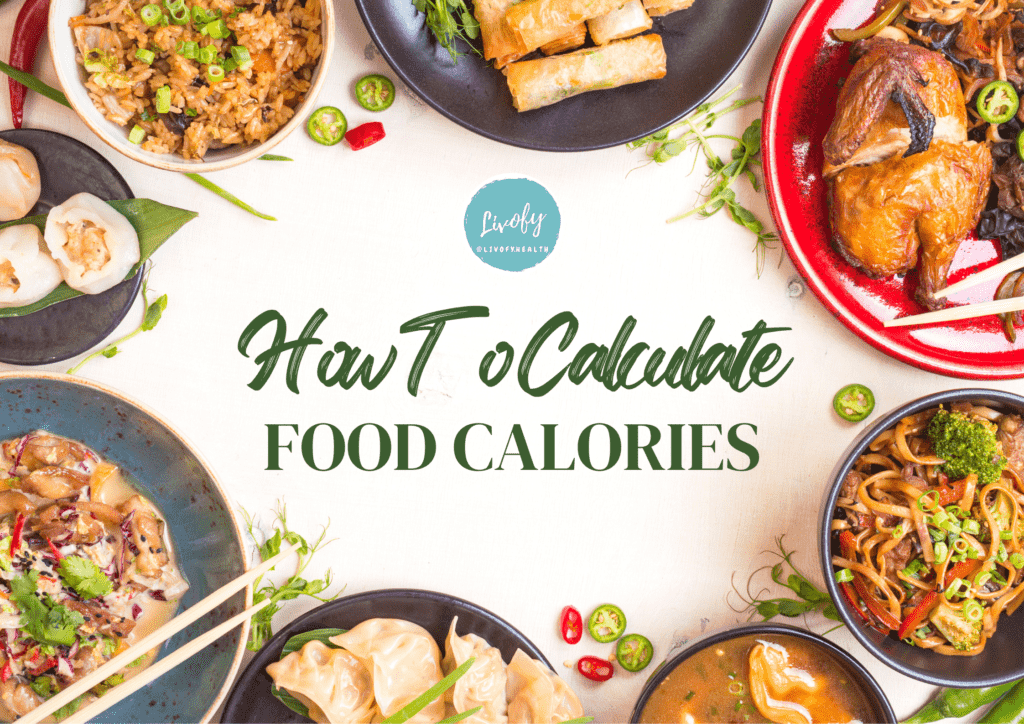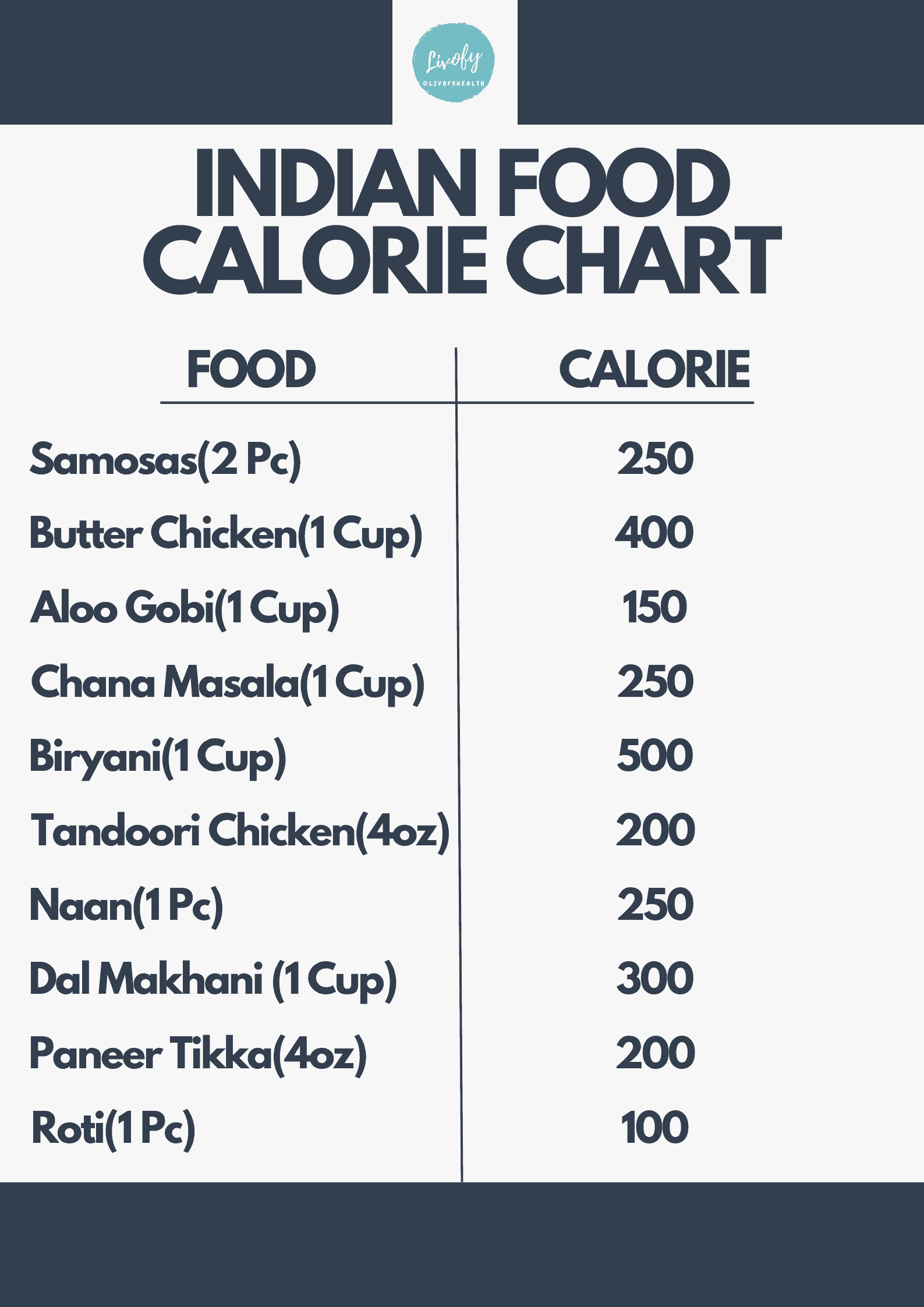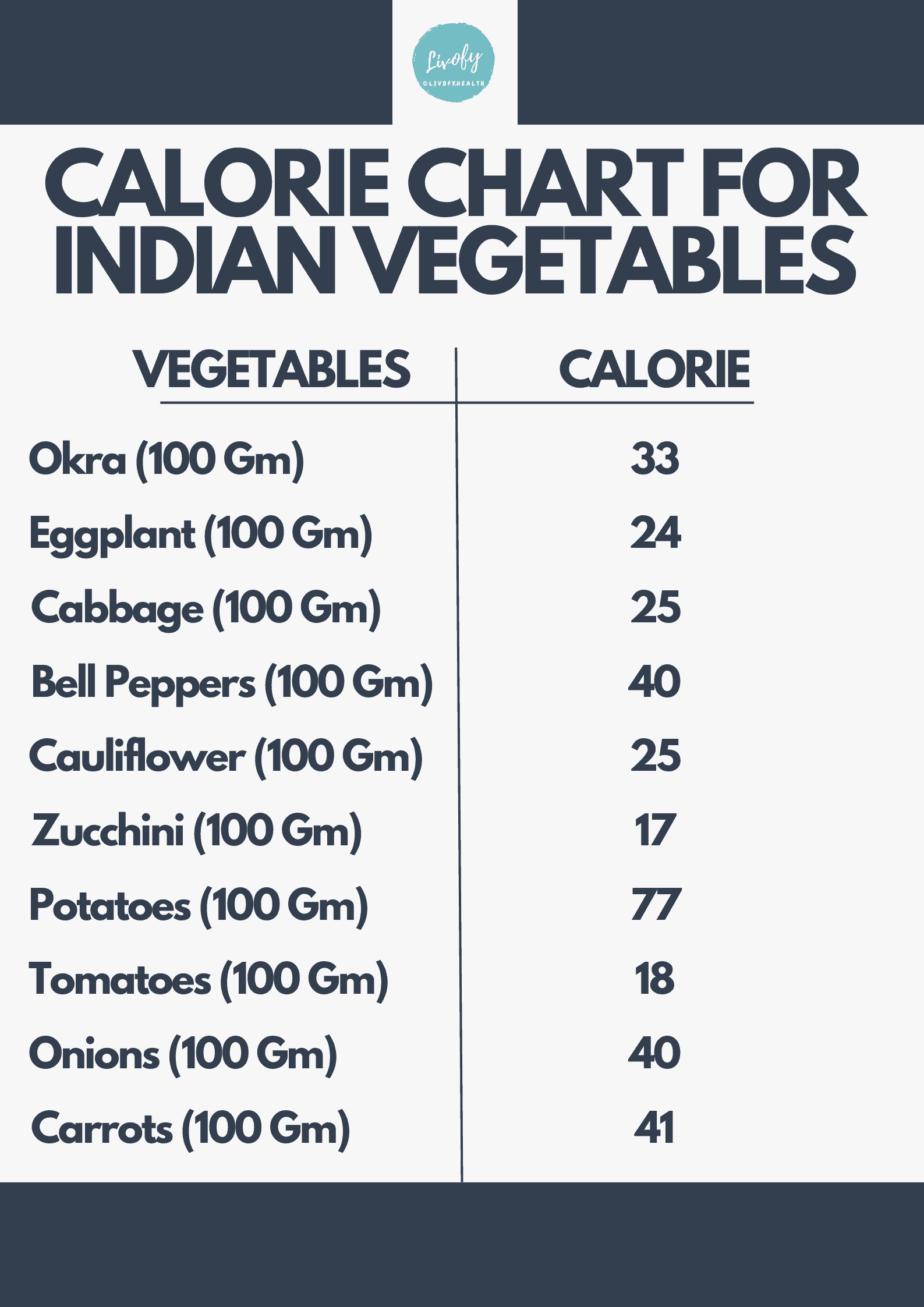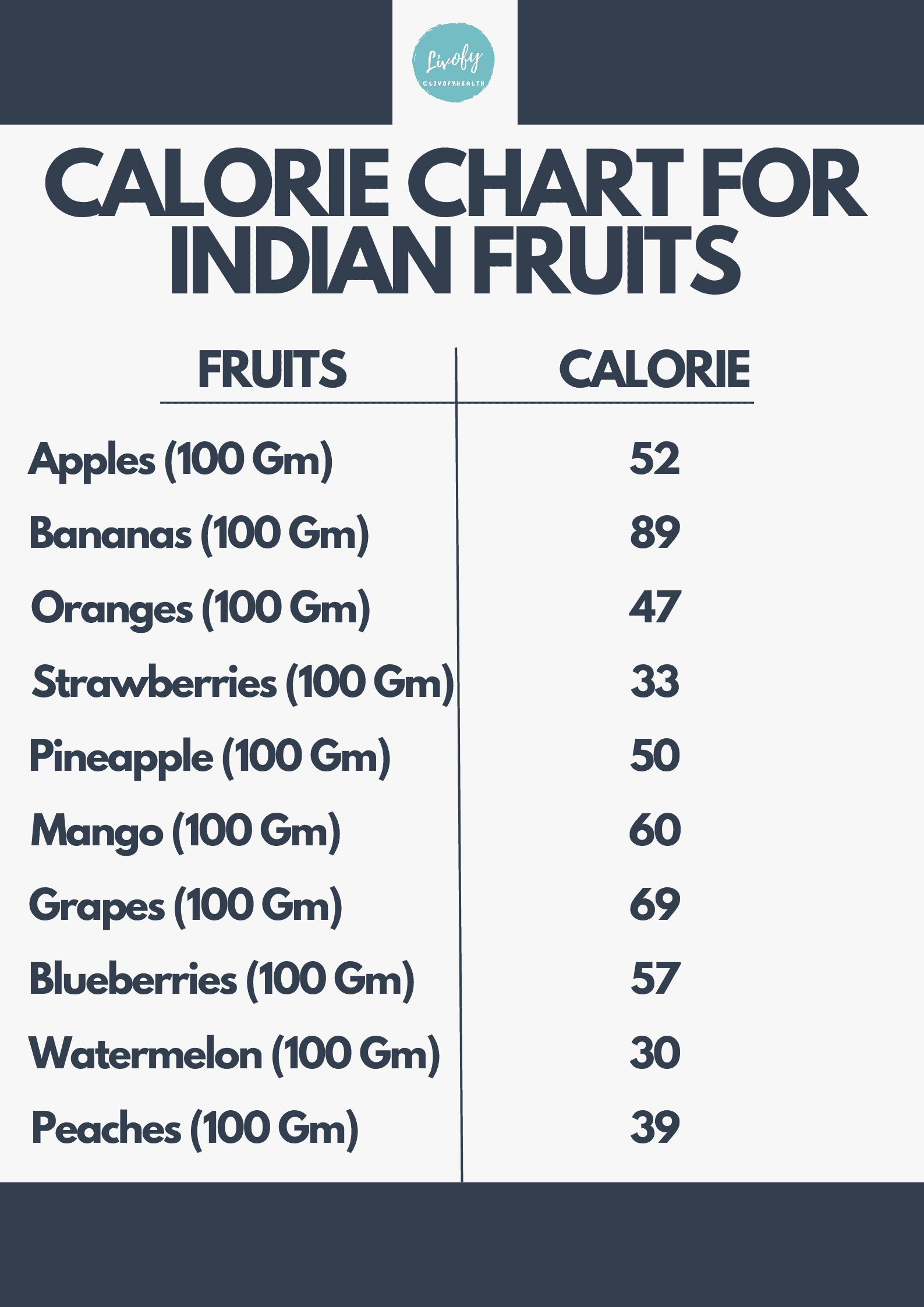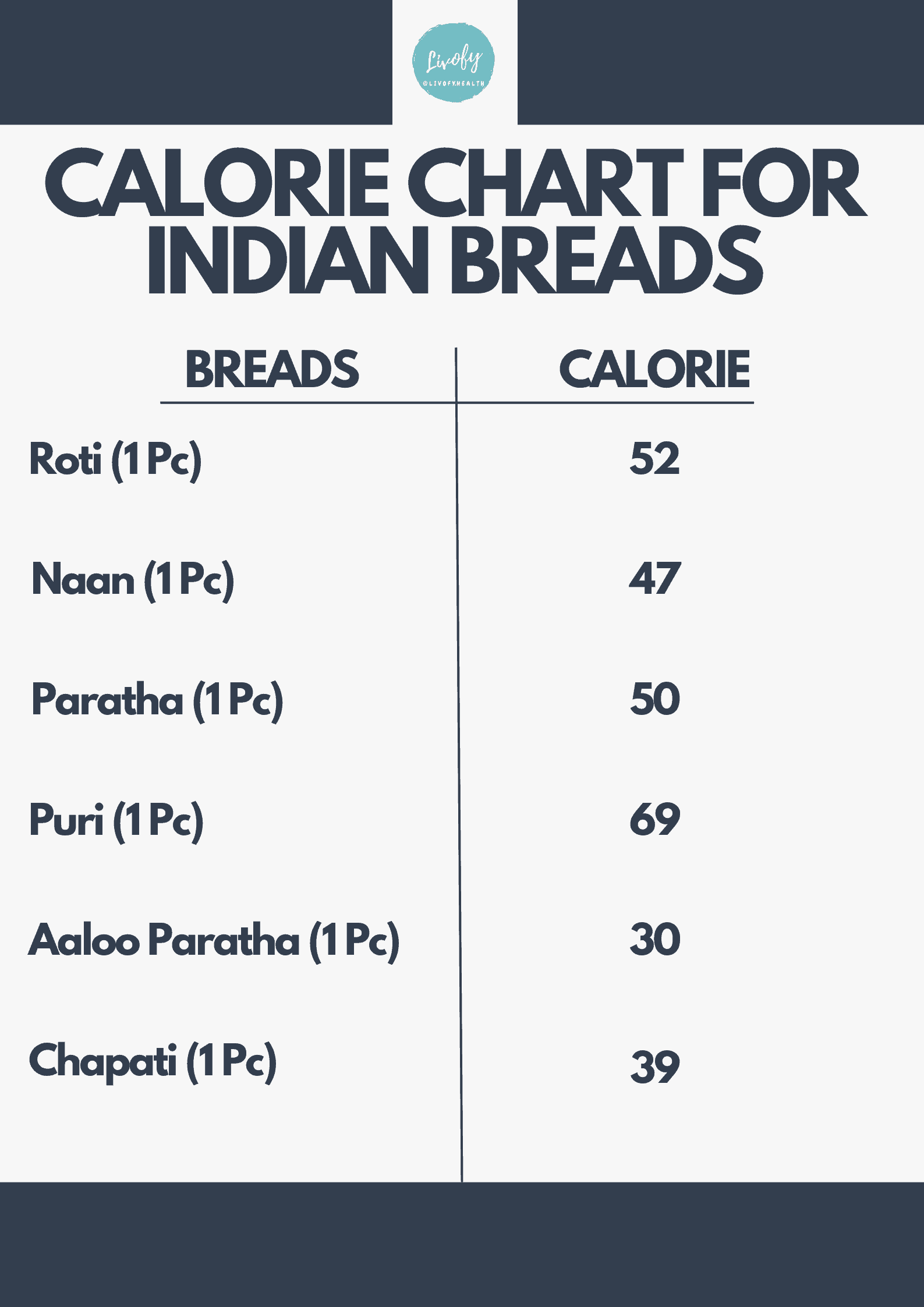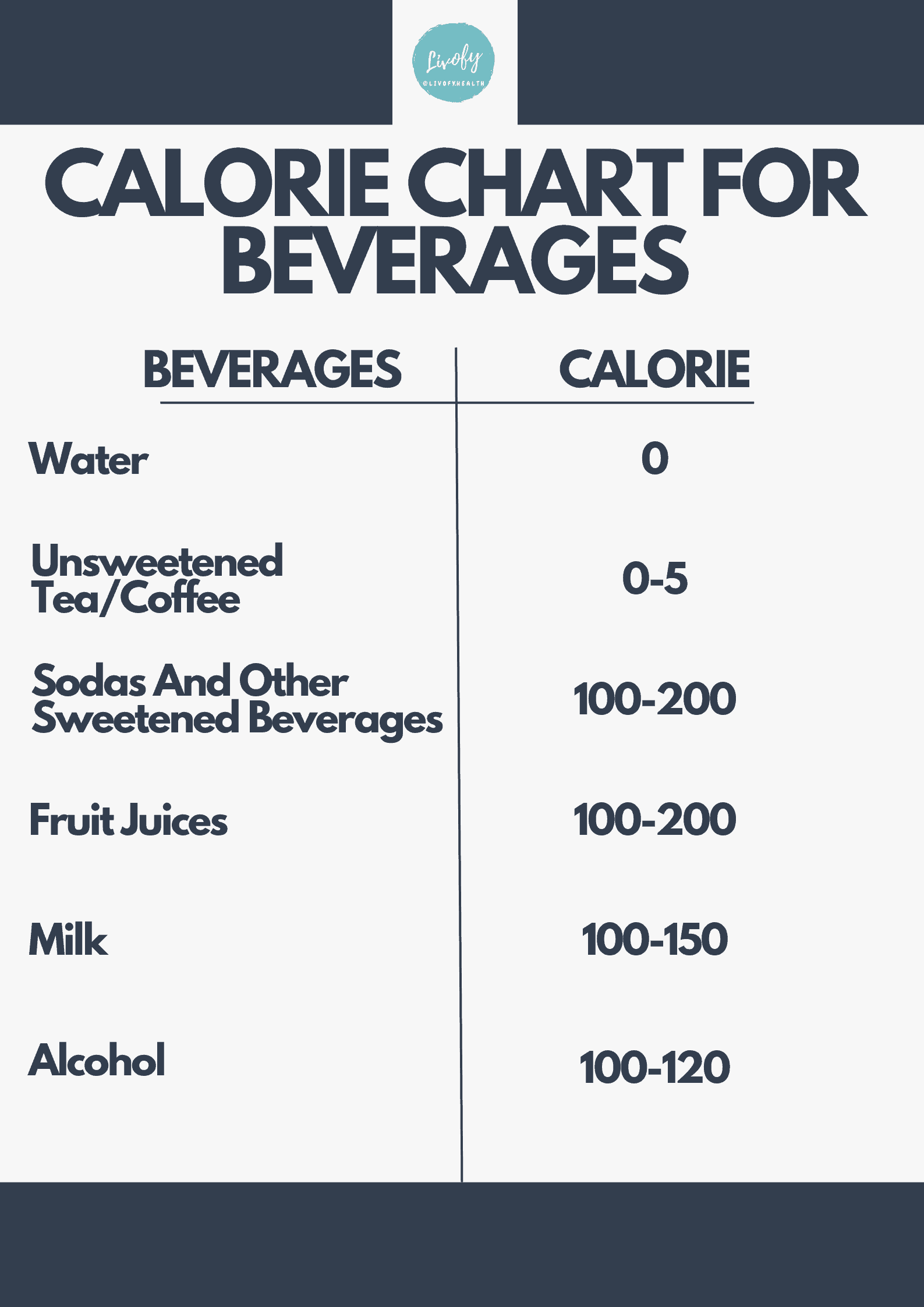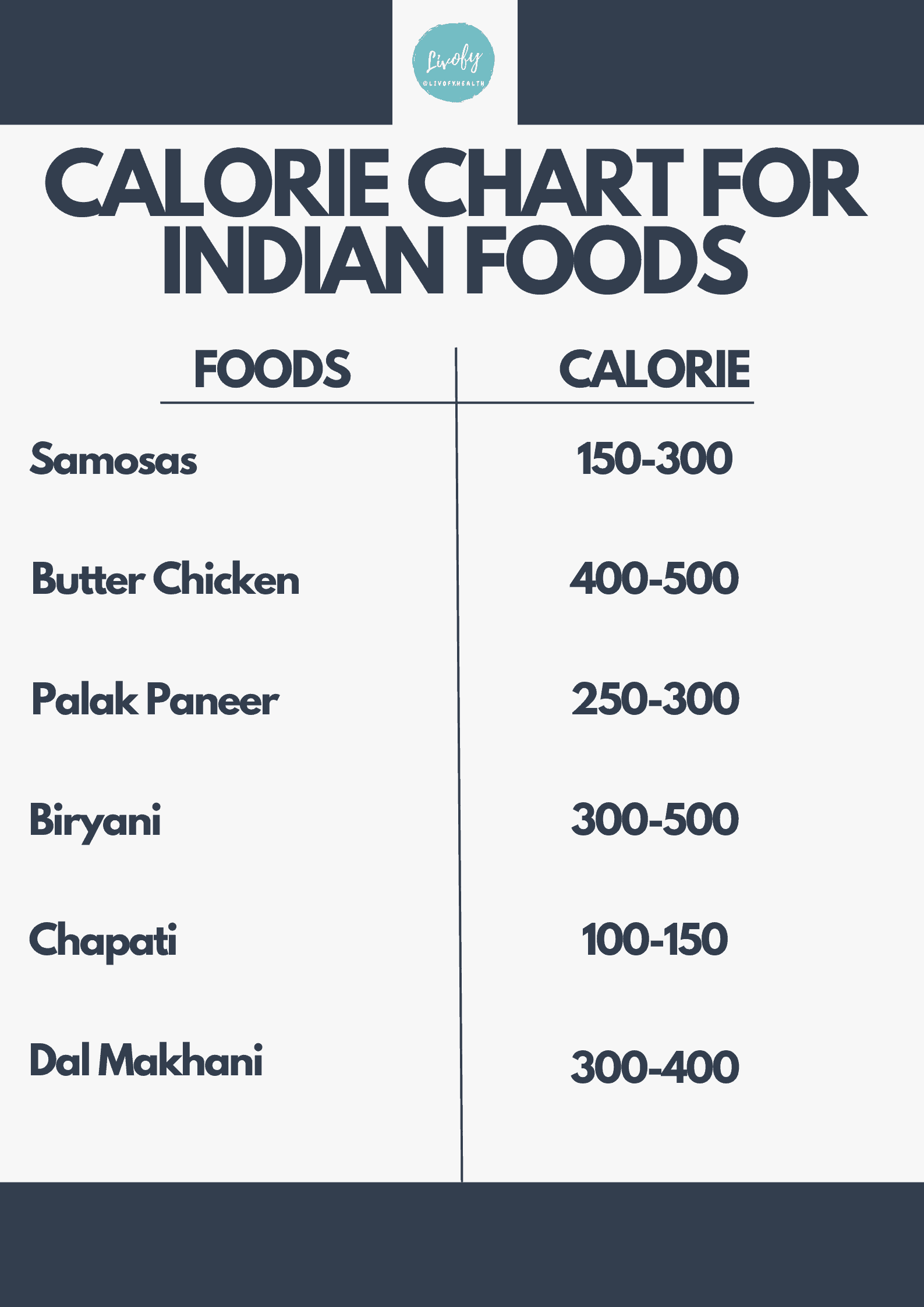Indian cuisine is known for its rich and diverse flavors, and it is enjoyed by people all over the world. However, like any type of food, it is important to know how to calculate calories in food (how to calculate food calories) and the dishes you eat. This is especially important if you are trying to maintain a healthy weight or are following a specific diet plan.
Indian Food Calorie Chart
To help you understand the calories of foods (some common Indian dishes), here is a nutrition food chart (calorie chart of food) for some popular Indian foods:
It’s important to note that the caloric content of these dishes can vary depending on the specific recipe and the ingredients used. Additionally, the portion size you choose can also impact the number of calories you consume.
To maintain a healthy diet, it is recommended to choose a variety of foods, including a balance of protein, carbohydrates, and fats. It is also important to pay attention to portion sizes, to be mindful of the total number of calories you consume on a daily basis, and to know how to calculate calories in food (how to calculate food calories).
By being mindful of the caloric content of the foods you eat, you can enjoy all the delicious flavors of Indian cuisine while still maintaining a healthy diet.
Daily Calorie Requirement – How many calories should you eat on average?
The number of calories of foods you should consume on a daily basis depends on a variety of factors, including your age, gender, weight, height, and physical activity level. The average adult needs to consume a certain number of calories each day to maintain their current weight. This number is known as the basal metabolic rate (BMR).
Your BMR is the number of calories your body needs to function at rest, and it accounts for about 60-75% of the total number of calories you burn each day. To determine your BMR or calculate calories in food (how to calculate food calories), you can use an Indian food calorie calculator or consult with a healthcare professional.
In general, adult men need to consume more calories than adult women, and active individuals need to consume more calories than sedentary individuals. Here is a general guideline for the average number of calories an adult should consume each day:
- Sedentary men (little or no exercise): 2,000-2,200 calories/day
- Sedentary women (little or no exercise): 1,600-1,800 calories/day
- Active men (moderate exercise): 2,400-2,600 calories/day
- Active women (moderate exercise): 2,000-2,200 calories/day
- Active men (intense exercise): 2,800-3,000 calories/day
- Active women (intense exercise): 2,400-2,600 calories/day
It’s important to note that these are just general guidelines, and the specific number of calories of foods you need may vary based on your individual circumstances. If you are trying to lose weight, you may need to consume fewer calories than your BMR, while if you are trying to gain weight, you may need to consume more calories.
It’s also important to choose nutrient-dense foods, rather than just focusing on the total number of calories you consume. A healthy diet should include a variety of fruits, vegetables, whole grains, lean proteins, and healthy fats.
In conclusion, the average number of calories an adult should consume each day depends on their age, gender, weight, height, and physical activity level. To calculate calories in food, you can use a Food Calorie Calculator India (Indian food calorie calculator) or consult with a healthcare professional.
Why Knowing The Calorie In Foods Is Important?
Knowing the calories in food you eat is important for a number of reasons. Here are a few reasons why it’s important to be aware of the calorie content of your food:
- Weight management: If you are trying to maintain a healthy weight, it’s important to be mindful of the number of calories you consume. First, calculate calories in food since consuming more calories than your body needs can lead to weight gain while consuming fewer calories can lead to weight loss.
- Balancing nutrients: While calories are important, it’s also important to choose foods that are nutrient-dense. This means that they provide a high amount of nutrients in relation to the number of calories they contain. By being aware of the calories in food, you can ensure that you are getting a balanced intake of nutrients.
- Portion control: Knowing the caloric content of your food can help you control your portion sizes. For example, if you know that a serving of a particular food contains 200 calories, you can choose a smaller portion size if you are trying to limit your caloric intake.
- Health benefits: In addition to helping with weight management and ensuring a balanced intake of nutrients, paying attention to the calories in food can also have other health benefits. For example, research has shown that consuming a diet low in calories can have anti-aging effects and may help to reduce the risk of certain diseases such as heart disease and diabetes.
In conclusion, knowing the caloric content of the foods you eat is important for weight management, balancing nutrients, portion control, and overall health. By being aware of the calorie content of your food, you can make informed choices about what to eat and how much to eat, which can help you achieve and maintain a healthy weight and overall health.
How To Calculate Your Food Calorie Intake?
If you are trying to be mindful of the number of calories you consume, it can be helpful to calculate calories in food. Here are some steps you can follow to calculate your food calorie intake:
- Determine your daily caloric needs: The first step in calculating your food calorie intake is to determine how many calories you need to consume each day. There are several Indian food calorie calculator that can help you determine your daily caloric needs based on your age, gender, weight, height, and physical activity level.
- Keep a food diary: One of the most effective ways to track your food intake is to keep a food diary. You can use a physical journal or an app to record everything you eat and drink each day, including the portion sizes.
- Look up the caloric content of your food: To calculate the number of calories you are consuming, you will need to know the caloric content of the foods you are eating. You can find the caloric content of foods on food labels, in a nutrition database, or by using a food calories list(Indian food calorie chart).
- Add up the calories: Once you have recorded all of the foods you have eaten in your food diary and have looked up their caloric content in a food calories list(Indian food calorie chart), you can add up the total number of calories you have consumed for the day.
- Compare to your daily caloric needs: After calculating your food calorie intake, you can compare it to your daily caloric needs. If you are trying to maintain your current weight, you should aim to consume roughly the same number of calories as your daily caloric needs. If you are trying to lose or gain weight, you may need to adjust your caloric intake accordingly.
- If you think that these steps may be too much for you to handle and go through, Calculate the Food Calorie using this calculator (food calorie calculator India/Indian food calorie calculator).
By calculating your food calorie intake by a food calories list (Indian food calorie chart), you can get a better understanding of the number of calories you are consuming each day. This can help you make informed choices about what to eat and how much to eat, which can be an important part of maintaining a healthy weight and overall health.
Daily Calorie Chart for Indian Vegetables
Indian cuisine is known for its rich and diverse flavors, and it often includes a variety of vegetables. If you are trying to be mindful of the number of calories you consume, it can be helpful to know the caloric content of the vegetables you eat. Here is a nutrition food chart (calorie chart of food/food calorie chart) for some common Indian vegetables:
It’s important to note that the caloric content of vegetables can vary depending on the specific variety and the way it is prepared. For example, fried okra will have more calories than boiled okra. Additionally, the portion size you choose can also impact the number of calories you consume.
To maintain a healthy diet, it is recommended to choose a variety of vegetables, including leafy greens, cruciferous vegetables, and root vegetables. It is also important to pay attention to portion sizes and to be mindful of the total number of calories you consume on a daily basis.
By being aware of the caloric content of the vegetables you eat by using a food calories list (Indian food calorie chart), you can enjoy all the delicious flavors of Indian cuisine while still maintaining a healthy diet.
Calorie Chart for Fruits
Fruits are an important part of a healthy diet, as they are rich in nutrients and provide a variety of health benefits. If you are trying to be mindful of the number of calories you consume, it can be helpful to know the caloric content of the fruits you eat. Here is a nutrition food chart (calorie chart of food) for some common fruits:
It’s important to note that the caloric content of fruits can vary depending on the specific variety and the way it is prepared. For example, dried fruit will have more calories than fresh fruit, as the water has been removed during the drying process. Additionally, the portion size you choose can also impact the number of calories you consume.
To maintain a healthy diet, it is recommended to choose a variety of fruits, including a mix of fresh and frozen, and to aim for at least 2 cups of fruit per day. It is also important to pay attention to portion sizes and to be mindful of the total number of calories you consume on a daily basis.
By being aware of the caloric content of the fruits you eat, you can enjoy all the delicious flavors and health benefits of fruit while still maintaining a healthy diet, and be sure to check our Weight loss blogs for more detailed info.
Calorie Chart for Indian Breads
Indian bread, such as roti, naan, and paratha, are a staple of Indian cuisine and is enjoyed by people all over the world. If you are trying to be mindful of the number of calories you consume, it can be helpful to know the caloric content of the Indian bread you eat. Here is a calorie chart of food (food calorie chart) for some common Indian bread:
It’s important to note that the caloric content of Indian bread can vary depending on the specific recipe and the ingredients used. Additionally, the portion size you choose can also impact the number of calories you consume.
To maintain a healthy diet, it is recommended to choose a variety of whole-grain bread and to pay attention to portion sizes. It is also important to be mindful of the total number of calories you consume on a daily basis.
By being aware of the caloric content of the Indian bread you eat, you can enjoy all the delicious flavors of this bread while still maintaining a healthy diet.
Calorie Chart for Beverages
If you’re trying to maintain a healthy diet, it’s important to be aware of the calorie content of the beverages you consume. While some drinks can be a low-calorie option to quench your thirst, others can contribute significantly to your daily caloric intake. Here is a calorie chart of food (food calorie chart) for some common beverages to help you make informed decisions about what to drink.
Water: 0 calories Water is the ultimate zero-calorie beverage. It’s essential for hydration and has no sugar or calories. Whether you’re trying to lose weight or simply maintain a healthy diet, water is an excellent choice.
Unsweetened tea and coffee: 0-5 calories Both tea and coffee can be low in calories, especially if you drink them unsweetened. A cup of black coffee usually has less than 5 calories, while a cup of unsweetened tea has around 2 calories. Adding a splash of milk or cream can increase the calorie content, but you can also use low-fat or skim milk to keep it low.
Sodas and other sweetened beverages: 100-200 calories Sodas and other sweetened beverages, such as sports drinks and energy drinks, can be high in calories due to their added sugar content. A can of soda typically has around 100-150 calories, while a bottle of sports drink can have around 50-80 calories. If you’re trying to cut back on your sugar intake, it’s best to limit your consumption of these types of beverages.
Fruit juices: 100-200 calories While fruit juices can be a good source of vitamins and minerals, they can also be high in calories due to their natural sugar content. A cup of orange juice, for example, has around 110 calories, while a cup of apple juice has around 120 calories. It’s important to keep in mind that fruit juices often lack the fiber found in whole fruits, which can help you feel full and satisfied.
Milk: 100-150 calories Milk is a good source of protein, calcium, and other essential nutrients. A cup of whole milk has around 150 calories, while a cup of 2% milk has around 120 calories. Skim milk has the lowest calorie content, with around 80 calories per cup.
Alcohol: 100-200 calories Alcoholic beverages can vary greatly in calorie content. A 12-ounce serving of beer has around 150 calories, while a glass of wine has around 100-120 calories. Hard liquor, such as vodka or whiskey, has around 100 calories per 1.5-ounce serving. It’s important to keep in mind that alcohol can also contribute to weight gain if consumed in excess.
In conclusion, the calorie content of beverages can vary greatly. While water and unsweetened tea and coffee are low in calories, sodas, fruit juices, milk, and alcohol can be higher in calories. By being aware of the calorie content of the beverages you consume, especially when you’re on a Weight Loss or a Keto Diet Plan, you can make more informed choices that support your overall health and wellness goals.
Calories In Indian Foods
Indian cuisine is known for its flavorful and aromatic dishes, but it’s important to be aware of the calorie content of the foods you eat. Some Indian dishes can be high in calories due to the use of oil, ghee, butter, and cream, while others can be lower in calories due to the inclusion of vegetables and legumes. Feel free to check out a few Weight loss Delicious Recipes, that we have in our archive just for you.
Here is a calorie chart of food (food calorie chart) for some common Indian foods:
Samosas: 150-300 calories Samosas are a popular snack in India, made with a fried or baked pastry filled with vegetables or meat. A single samosa can have around 150-300 calories, depending on the filling and size.
Butter chicken: 400-500 calories Butter chicken, also known as murgh makhani, is a rich and creamy dish made with marinated chicken in a tomato and butter-based sauce. A single serving can have around 400-500 calories.
Palak paneer: 250-300 calories Palak paneer is a dish made with paneer (a type of Indian cheese) and spinach cooked in a spiced tomato and cream sauce. A single serving can have around 250-300 calories.
Biryani: 300-500 calories Biryani is a rice dish made with a combination of spices, vegetables, and meat or seafood. A single serving can have around 300-500 calories, depending on the ingredients and portion size.
Chapati: 100-150 calories Chapati is a type of Indian flatbread made with whole wheat flour. A single chapati has around 100-150 calories, depending on the size.
Dal makhani: 300-400 calories Dal makhani is a dish made with black lentils and kidney beans cooked in a spiced tomato and cream sauce. A single serving can have around 300-400 calories.
FAQs
How many calories should I eat a day by age?
It’s important to note that the number of calories a person needs each day can vary based on a variety of factors, including age, gender, weight, height, activity level, and metabolism. As a general rule, the average adult needs around 2000-2500 calories per day to maintain their weight. However, this can vary significantly depending on the individual.
Here are some general guidelines for calorie needs by age:
- Children (4-8 years old): 1000-1400 calories per day
- Children (9-13 years old): 1400-1900 calories per day
- Teens (14-18 years old): 1600-2400 calories per day
- Adults (19-30 years old): 2000-2500 calories per day
- Adults (31-50 years old): 1800-2300 calories per day
- Adults (51+ years old): 1600-2000 calories per day
Again, these are just general guidelines, and it’s important to consult with a healthcare professional or registered dietitian to determine your specific calorie needs. They can take into account your individual factors and help you create legit Weightloss Diet Plans that meet your needs.
How can I calculate my food calories?
There are a few different ways to calculate the calorie content of the food you eat:
- Use a calorie calculator (food calorie calculator India): There are a number of online calorie calculators (calorie chart of food) that can help you estimate the calorie content of your meals. Simply enter the ingredients and portion sizes of the foods you’re eating, and the calculator (food calorie calculator India) will provide an estimate of the total calorie content by using a list of food items with calories (calories in food items).
- Check food labels: Most packaged foods in the United States are required to have a nutrition label that lists the calorie content per serving. You can use this information to calculate the calorie content of your meals.
- Use a food diary: A food diary is a record of everything you eat and drink in a day, along with the corresponding calorie content. You can use a food diary app or website to track your food intake and calculate the total calories for the day.
- Consult a registered dietitian: A registered dietitian can help you determine your specific calorie needs and create an Expert Diet Treatment that meets those needs. They can also provide guidance on how to track your food intake and calculate the calorie content of your meals by using a list of food items with calories (calories in food items).
It’s important to note that the accuracy of these methods can vary, and it’s always best to consult with a healthcare professional or registered dietitian for personalized advice.
How many calories should an infant needs?
The calorie needs of infants can vary based on their age, size, and activity level. As a general rule, infants need more calories per pound of body weight than adults do, since they are growing and developing rapidly.
Here are some general guidelines for calorie needs in infants:
- Newborns (0-3 months old): around 100-160 calories per kilogram of body weight per day
- Infants (4-6 months old): around 90-120 calories per kilogram of body weight per day
- Infants (7-12 months old): around 80-100 calories per kilogram of body weight per day
It’s important to note that these are just general guidelines, and the specific calorie needs of an infant can vary based on their individual factors. It’s always best to consult with a healthcare professional and use a calorie chart of food to check food items with calories (calories in food items) or a registered dietitian to determine the appropriate calorie intake for your infant. They can take into account your infant’s age, size, activity level, and other factors to create a personalized feeding plan.

